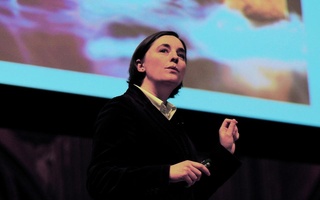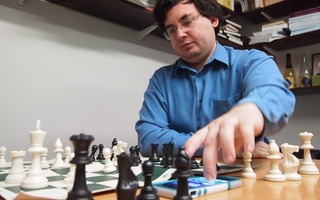The clutter of Joseph K. Blitzstein’s office on the 7th floor of the Science Center seems to suggest the classic trappings of a college professor—except, perhaps, the rather extensive collection of feline memorabilia.
“I don’t really collect cat stuff,” Blitzstein, a professor of the practice in the Statistics Department said. “But people give me cat stuff because they know I like cats.”
Blitzstein is the proud owner of two cats—“big fluff balls,” as he calls them. “Worf is the older one, and Jack is the younger one,” he said, clarifying, “Yes, like Star Trek.”
But aside from his love of cats and science fiction, Blitzstein is perhaps best known among undergraduates for his passion for statistics. Since joining the Statistics Department in 2006, Blitzstein’s introductory probability course, Statistics 110, has seen a nearly sixfold increase in enrollment. In addition, the number of undergraduate concentrators in the Statistics Department, for which Blitzstein serves as co-director of undergraduate studies, has increased every year since 2008.
Despite growing interest nationwide in statistics and “big data” over the past decade, students and faculty in the department have said that much of the new excitement for the field at Harvard is due to Blitzstein’s personal commitment to teaching and the enormous influence he has had on the undergraduate body.
TELLING STORIES
Statistics professor Carl N. Morris remembers interviewing Blitzstein for a teaching position in the department nearly eight years ago. At the time, Blitzstein had just finished up a doctoral degree in mathematics at Stanford.
“He seemed to be very interested in many things, he knew a lot about science, he knew a lot about other things too,” Morris said. “I knew he was a good choice, but I had no idea how good he would be.”
Statistics professors and students say that what makes Blitzstein’s teaching so unique are the real-life examples he uses to introduce complex statistical concepts.
“The key is his ‘stories,’” Morris said. “He’s just very good during lectures at telling stories, not just putting formulas up on the board but telling a story on how you can figure out something very interesting.”
“One of the best things about his teaching style is that he’s very good at laying out examples in a very logical manner so they naturally build on each other,” said Matt J. Rauen ’16, a mathematics and computer science concentrator who took Stat 110 this fall.
Blitzstein said that he decided to teach because he has always enjoyed explaining ideas to other people.
“There’s just this special feeling when you kind of see the light bulb going off...when the concept is really difficult, but then it suddenly clicks for the student,” Blitzstein said. “I really enjoy those moments.”
Blitzstein’s teaching style has also been an inspiration for his colleagues. “I would say Joe has taught me a lot about how to teach at Harvard,” said professor of the practice of statistics Stephen Blyth, who is also the head of public markets for the Harvard Management Company.
According to colleagues and students, Blitzstein’s style has helped to fuel the growth of Stat 110, the probability course that serves as a gateway into the concentration. When Blitzstein first taught the class in 2006, it counted 80 students. This fall, 460 undergraduates took the course.
Read more in Faculty News
Af-Am Professors Reflect on Mandela’s Legacy at HarvardRecommended Articles
-
 Student Serenades Stat 110
Student Serenades Stat 110 -
Statistics Department Hopes to Continue GrowthWith Wednesday's deadline for sophomore concentration declarations imminent, Harvard’s Statistics Department looks to continue an escalation that has seen the concentration expand from 5 to 50 concentrators since 2005.
-
 Professors and a Student Think Outside of the Box
Professors and a Student Think Outside of the Box -
 Chess with Blitzstein & Elkies: The Pawn is Mightier than the Sword
Chess with Blitzstein & Elkies: The Pawn is Mightier than the Sword -
Stats Department Expands to Accommodate Upward Trend in ConcentratorsAfter a statistically significant growth in concentrators in recent years, several professors say Harvard’s Statistics Department is reaching its limit.














